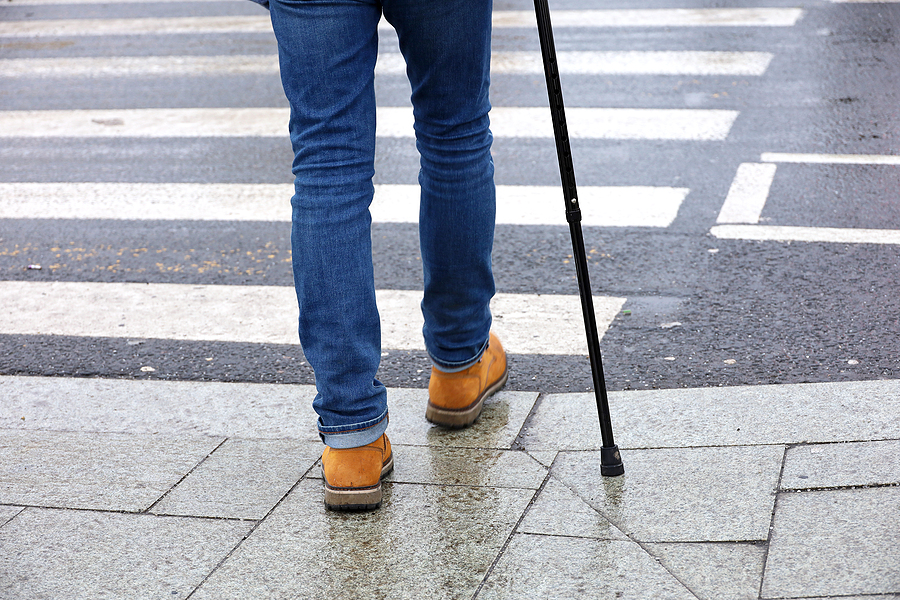 A cane may be recommended by a doctor or physical therapist to support balance and stability. Coordination issues, balance difficulties, and muscle weakness may develop due to injuries, a disability, degenerative diseases, or surgical procedures. When minor assistance is needed to move around, a cane may offer sufficient help.
A cane may be recommended by a doctor or physical therapist to support balance and stability. Coordination issues, balance difficulties, and muscle weakness may develop due to injuries, a disability, degenerative diseases, or surgical procedures. When minor assistance is needed to move around, a cane may offer sufficient help.
In some cases, the use of a cane is temporarily needed to promote balance and stability during recovery from an injury or following surgery. However, certain conditions (e.g., serious stroke, Parkinson’s, multiple sclerosis), a major disability, or even the aging process may cause some people to rely on a cane daily for long-term use.
The standard cane has a single-point base, but a quad cane that consists of four bases is also available. The quad cane offers more support due to its broader base, but it is also harder to use than the single-point cane. There are also different types of grips and heights that provide added comfort while holding a cane. The choice of a grip often depends on personal preference, while the height and base of a cane (single-point versus quad) depend on physical factors (e.g., person’s height, hand strength) and limitations (e.g., injury type or condition). Additionally, choosing the appropriate grip and height can reduce stress on the joints.
Speaking with a trained professional can help ensure that the right type of cane is chosen. Canes that are purchased without professional advice may lead to unsafe and inefficient use.
How to Choose and Use the Right Cane
When choosing a cane, it may be best to work with a healthcare professional such as a physical therapist who can direct the decision-making process. In addition, a doctor may recommend physical therapy that involves learning how to use a cane for rehabilitation purposes.
Two of the most important aspects of cane selection are base structure and height. Most people prefer to use a single-point cane, but a physical therapist may insist that a quad cane be used for cases of severe balance issues such as following a major stroke. Quad canes are a little more difficult to use initially, but physical therapists specialize in helping individuals learn how to use any type of cane. A quad cane, depending on the style, may also need the base, or the actual quad portion of the cane, adjusted or turned so that the legs of the quad base portion of the cane are not impeding on a walking or gait pattern.
Next, it is important to ensure that the cane is of appropriate height. It is best to select a cane that can be adjusted, these are metal canes with sliding pins for selecting the correct height, rather than a wood cane that may need to be cut to the proper height if it is too high or can’t be lengthened if it is too short. An heirloom wood cane, that a person may wish to use for sentimental reasons and not be willing to shorten/cut if it is too high/tall, is not always the best option. Proper cane height is when the top/crest of the cane handle reaches the crease of the wrist. Furthermore, the elbow should bend at a comfortable angle of about 15-20 degrees while holding the cane. A cane that is too long may be hard to move and one that is too short may cause an individual to lean forward or to one side. Pain in the elbow or lower back and leaning to one side indicates that the cane height is wrong.
Another key aspect is grip comfort. When gripping a cane, pain or numbness in the fingers or hand indicates that the wrong type of grip was chosen. A physical therapist can monitor the use of a cane and assess possible complications (finger pain) to help make any necessary adjustments or suggest a different cane.
Your physical therapist will also educate you about what hand your cane should be in so that you may maximize the use of a cane to its full potential for your condition. With leg surgeries and injuries the cane needs to be used in the opposite hand of the leg that requires support. This is so that the weight can be shifted off the involved leg and transferred to the other/good leg, making it easier to walk with the “swing” phase of a gait pattern. A physical therapist can show you how to walk properly with a cane using this technique and biomechanical principle.
If you or your loved one requires a cane to assist with balance and stability, a physical therapist at Dynamics Physical Therapy can guide you through this process. Not only will our dedicated physical therapists offer recommendations during the selection process, but they will also show you or your loved one how to properly use a cane. Choosing the right cane and using it efficiently can help prevent further injuries and falls—a major risk factor for disability. A cane now can also be a fashionable walking accessory with the colours, patterns and designs that are now available on the market to suit a user’s personality; ladies there are even designer canes with “bling”.
Call today to speak with a highly trained physical therapist who can make the transition to using a cane much easier and safer.
References
1. Bradley SM, Hernandez CR. Geriatric assistive devices. Am Fam Physician. 2011;84:405.
2. Allet L, Leemann B, Guyen E., et al. Effect of different walking aids on walking capacity of patients with poststroke hemiparesis. Arch Phys M. 2009;90:1408.
3. Lam R. Choosing the correct walking aid for patients. Can Fam Physician. 2007;53(12):2115-2116.
4. Beauchamp M, Skrela M, Southmayd D, et al. Immediate effects of cane use on gait symmetry in individuals with subacute stroke. Physiother Can. 2009;61(3):154-160.
5. Hesse S, Jahnke MT, Schaffrin A, et al. Immediate effects of therapeutic facilitation on the gait of hemiparetic patients as compared with walking with and without a cane. Electroen Clin Neuro. 1998;109:515-522.


